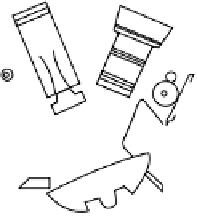Information Technology Reference
In-Depth Information
Important versus Critical
Figure A.2
Seat belt versus engine.
PERT deals with schedules. Many think that by calling something a
critical
activity
on the schedule that they have raised its priority. They have not.
Critical paths change during a project. As such, an activity may be critical
today, but not (critical) next week due to something else happening in
another activity.
A set of related terms often used is
.
Features are often classified according to these categories (Figure A.2). A
confusion arises because, in the customer's mind, “nice to have” is also
part of the delivery, only less important than the other ones. The customer
expects the entire list — essential
essential
versus
nice to have
nice to have — to be delivered.
However, the delivery team may treat “nice to have” as optional items
and ignore them.
and
Horizontal versus Vertical
This has been a topic of constant discussion in computer science circles
and a perennial source of confusion among management and marketing
people. An ERP (Enterprise Resource Plan) offering is considered hori-
zontal by its product design teams. Its version for a particular industry,
such as oil and gas
is considered a vertical. On the other hand, the oil
and gas company may consider its ERP as a horizontal application, while
its software to manage the
,
is considered
vertical. For developers, it is the struggle between using a BFS (breadth
first search) tree traversal algorithm or the generic branch-and-bound
(vertical traversal) technique. Is the definition of horizontal and vertical
arbitrary?
In marketing and general usage, something that is more foundational
is called horizontal. It meshes with the visual imagery of horizontal. A
platform — ERP, CRM, etc. — is horizontal. Such systems provide the
offshore exploration platform































